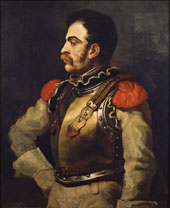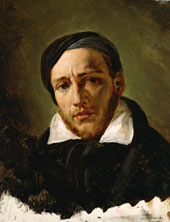|
|
| Presentation of the work : A Carabineer |
 |
Born at the height of the French Revolution, Théodore Géricault received a classical training, but quickly turned to modern subjects drawn from recent events. He loved horses and was drawn to the splendid uniforms of Napoleonic soldiers, creating numerous canvases and sketches of soldiers. The anonymous figure shown in A Carabineer, currently on display at Museum Lab, forms part of this series.
In stripping his model of any social identity, and thus of historical memory, Géricault demonstrates his interest in the real world. This portrait sums up the very essence of his style. His broad, vigorous brushwork is the antithesis of the polished style of the leader of the French school, David. In its modernity and the way it captures the soldier’s personality, this picture greatly surpasses the idealized celebration that was characteristic of official portraits. It prefigures The Raft of the Medusa, one of the great works of Romanticism. |
 |
| Introduction to the artist : Théodore GÉRICAULT (1791–1824) |
 |
Born in 1791 in Rouen to a wealthy family, Géricault began to pursue a career as an artist at an early age, receiving a classical training. He abandoned subjects drawn from antiquity, choosing themes from everyday life, which he elevated to the rank of heroic events. The vibrant brushwork that characterizes his first great canvases on military subjects is reminiscent of the violent style of Antoine-Jean Gros, painter of Napoleonic battles. Géricault’s interest in human suffering is an essential part of his art. In his famous Raft of the Medusa, survivors and corpses are piled up chaotically on top of each other. In his choice of subjects and style, Géricault established himself as a major exponent of the emerging Romantic movement. His work exerted a decisive influence on a whole generation of artists, beginning with Eugène Delacroix. Géricault died in 1824 at the age of 32, leaving several major artistic projects incomplete. |
|

